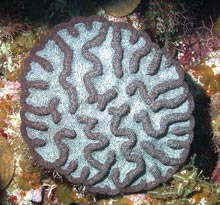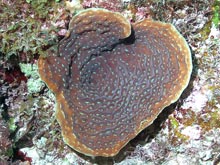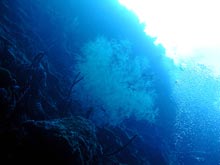One of the more common deep-reef corals on the Little Cayman walls is Mycetophyllia spp., since it prefers low-light conditions. In fact, on shallow reefs, Mycetophyllia polyps are often retracted during the day. Click image for larger view and image credit.
Plating agaricids are common down to about 200 feet (60.9 meters) on the Little Cayman walls. In shallower water they tend to form smaller plates with upright ridges. These differences in morphology may be a mechanism to efficiently gather light for their zooxanthellae. Click image for larger view and image credit.
Deep Corals
May 27, 2007
Marc Slattery
University of Mississippi
Michael Lesser
University of New Hampshire
One of our primary goals for this Ocean Explorer program has been to characterize deep coral-reef communities in order to determine whether the patterns we find in the Cayman Islands are broadly applicable to the wider Caribbean. After our first few deep dives, we now have a general first impression of the differences between our prior work on the walls of the Bahamas, and our current dive sites on the walls of Little Cayman. Several zooxanthellate corals (corals that contain zooxanthellae and are, therefore, light dependent) can be found to depths of about 300 feet (91.4 meters) in the Bahamas; these include Leptosiras cuculata, Montastraea cavernosa, and Agaricia lamarckii. On Little Cayman, corals are much less common below 200 ft (60.9 m), although azooxanthellate species (corals that do not contain zooxanthellae and are, therefore, not light dependent) are not uncommon. However, sponge biomass and diversity is very high on Cayman walls compared to the walls of the Bahamas. This qualitative observation suggests there are some fundamental differences among regional deep-reef communities that bear further study.
A potential source of this regional variation in community biodiversity is the nutrients available at each site. Many reef corals receive a significant amount of their energy budget from their algal symbionts, although they are also capable of feeding on various planktonic organisms. In contrast, sponges are ecologically important filter feeders on shallow and deep reefs. Differences in the reef slope angle may lower the available sunlight to deep corals, thus affecting zooxanthellae primary production. These differences in reef slope might also impact current patterns, resulting in differences in nutrient flux and, consequently, filter-feeder growth. If this hypothesis is correct then we would expect to see less light and more nutrient upwelling in Little Cayman. An Integrated Coral Observing Network (ICON) buoy should be moored off the Little Cayman Research Center before our second field season (in June 2008). We plan to tap into this powerful sensor package and dataset to further understand the role of oceanographic processes in shallow and deep coral-reef ecosystems.























